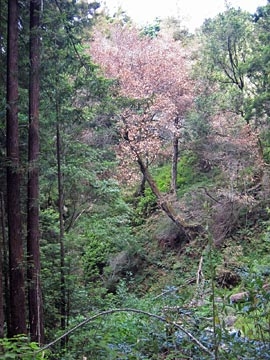Volunteers battle Sudden Oak Death
To better understand the extent of sudden oak death in California, UC Berkeley professor Mateo Garbelotto is enlisting volunteers in "SOD blitzes" to scour neighborhoods and wildlands for symptoms of the devastating disease, according to a story in the Oakland Tribune.
Sudden oak death, caused by a fungus Phytophthora ramorum, has resulted in widespread dieback of coast live oak, California black oak, Shreve oak, tan oak and canyon live oak in Central and Northern California and Oregon coastal areas.
The Oakland Tribune article, written by Jonathon Morales, said the blitz isn't comprehensive or scientific, but Garbelotto believes the volunteers' efforts are helpful. The SOD blitzes inform and educate the community about Sudden Oak Death, get locals involved in detecting the disease, and produce detailed local maps of disease distribution."If you were to think, 'Oh, I know where sudden oak death is' and you're using data that was produced two years ago, probably you actually don't have a good idea where it is," Garbelotto was quoted.
The blitzes also benefit property owners by letting them know whether their own trees are infected. If detected early, Garbelotto said, there's a chance a property owner can save the tree.
Blitzes are scheduled for April and May. Dates, locations, contact information and reports on previous blitzes are on Garbelotto's Forest Pathology and Mycology Lab Web site.

A Big Sur tan oak that succumbed to sudden oak death.

